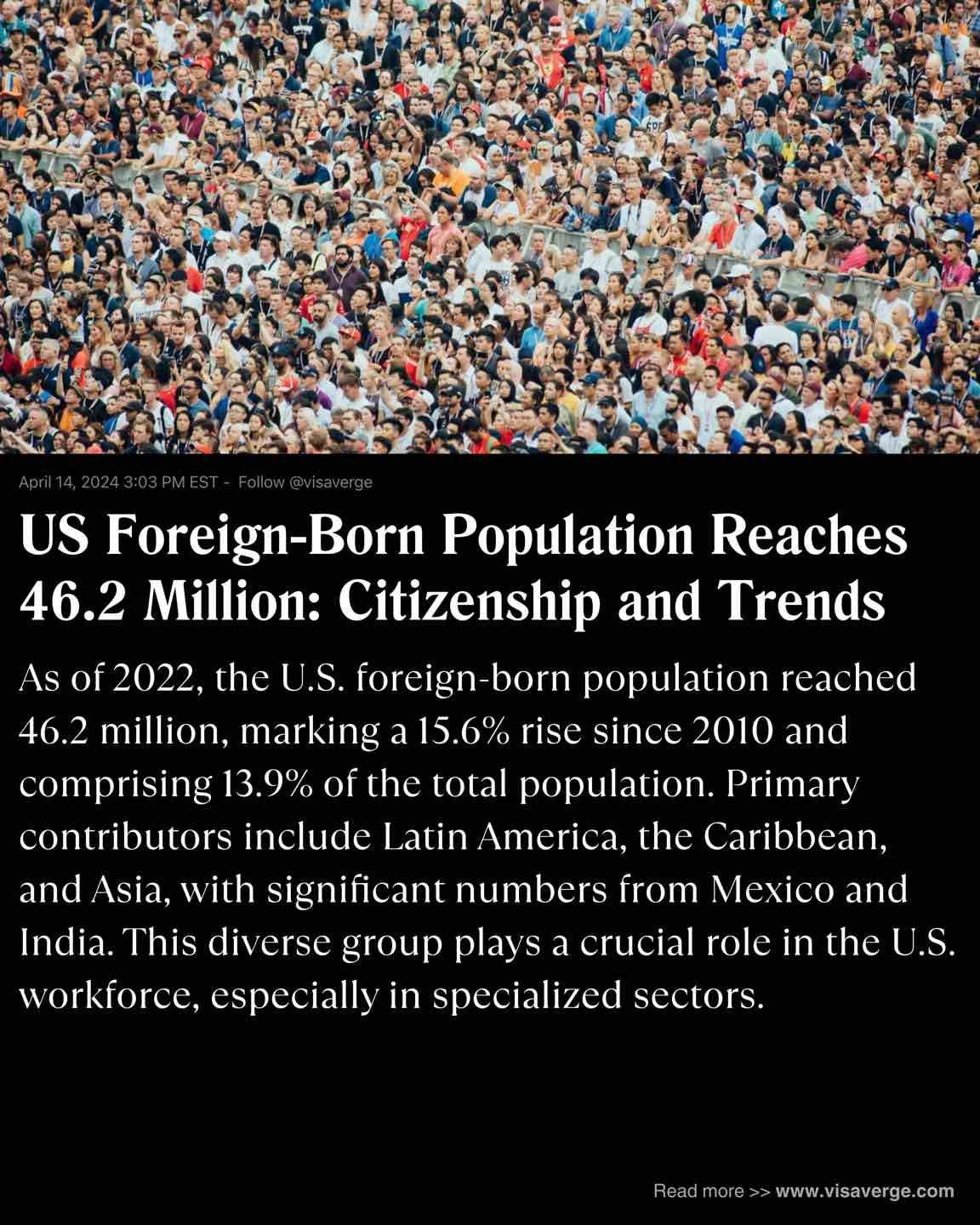What is the Current Size of the Foreign-Born Population in the US?
Recent data reveals that the foreign-born population in the US has seen a significant increase over the past decade. As of 2022, there are an estimated 46.2 million people who were not born in the United States but now reside there. This figure represents a 15.6 percent increase from 2010 when the foreign-born population was 40 million. Notably, these individuals now make up 13.9 percent of the overall US population. A comparison with historical data underscores the US’s role as a nation of immigrants. In 1970, for example, foreign-born individuals accounted for only 4.7 percent of the population.

What Regions and Countries Contribute Most to the US Foreign-Born Population?
The roots of America’s immigrant population are vast and varied. An analysis from the “The Foreign Born Population in the US: 2022” report by the US Census Bureau indicates that nearly half of all immigrants (49.1 percent) living in the US as of 2022 arrived before the year 2000. The regions contributing heavily to these numbers include Latin America and the Caribbean, with Mexico noted as a significant source country. From this region alone, the immigrant population grew by 9.5 percent from 2010 to 2020, totaling 23.23 million.
Asia follows closely with a substantial increase in residents coming to the US. From 2010 to 2022, the number of Asian-born residents, including those from India and China, increased by a remarkable 27 percent, reaching 14.35 million.
Who Are the Foreign-Born US Residents?
The term “foreign-born” encompasses anyone in the US who was not a US citizen at birth. This diverse group includes green card holders, temporary immigrants such as foreign students, and refugees, as well as unauthorized migrants. Over time, a large number of these individuals choose to become American citizens. Indeed, according to US Citizenship and Immigration Services, nearly 8.7 lakh foreign nationals acquired American citizenship in fiscal year 2023. Of these, 12.7 percent were from Mexico, making it the top source country for new US citizens, followed by India, which accounted for 6.7 percent of the new citizenships.
How Does the Profile of the Foreign-Born Population Compare to the Native-Born?
It’s not just the numbers that tell a story but also the demographics. The foreign-born population in the US is generally older and more educated than their native-born counterparts. As of the latest reports, the median age of foreign-born individuals was 46.7 years, compared to 36.9 years for those born in the US. Educationally, about a quarter of the foreign-born population aged 25 and above hold at least a bachelor’s degree, which is a slightly higher rate than that of the native-born population.
What Contribution Does the Foreign-Born Population Make to the US Workforce?
The economic contributions of the foreign-born population are significant, with 63.5 percent employed across various sectors such as management, business, science, and arts. This percentage illustrates the critical role that immigrants play not only in labor-intensive industries but also in fields that require high levels of education and specialization.
What Trends in Immigration Can We Expect?
Immigration remains a vital part of the American narrative and is a persistently hot topic during periods like the run-up to Presidential elections. Debates and policies continue to shape the landscape of US immigration. Understanding these dynamics is essential for comprehending how the United States continues to evolve as a diverse nation.
As the US increasingly acknowledges the contributions of its foreign-born residents, the discourse around immigration further emphasizes the integration and rights of these individuals. For more official, detailed statistics and insights on US immigration, visiting the US Citizenship and Immigration Services (USCIS) website can provide authoritative information.
Learn Today:
Here is a Glossary of Definitions section that elaborates on the specialized terminology related to immigration mentioned in the content provided:
- Foreign-Born Population: This term refers to individuals living in a country who were not citizens at birth and did not acquire citizenship automatically. In the U.S., this group includes naturalized citizens, permanent residents, temporary migrants (such as students), refugees, and unauthorized immigrants.
Green Card Holders: Legally known as lawful permanent residents (LPRs), these are non-citizens who have been granted authorization to live and work permanently in the United States.
Temporary Immigrants: Individuals who enter a country on a temporary basis for a specific purpose, such as students, temporary workers, or tourists. Their stay is bound by visa regulations specific to their designated category.
Refugees: People who are forced to flee their country because of persecution, war, or violence. Refugees have well-founded fears of persecution for reasons of race, religion, nationality, political opinion, or membership in a particular social group and cannot return home or are afraid to do so.
Unauthorized Migrants: Individuals who enter or reside in a country without the appropriate legal permissions. This group is also commonly referred to as undocumented immigrants.
Naturalized Citizens: Foreign-born individuals who have met the requirements set by a citizenship authority (such as USCIS in the U.S.) to become citizens of their resident country after fulfilling residency and other criteria.
US Citizenship and Immigration Services (USCIS): A component of the United States Department of Homeland Security (DHS) that administers the country’s naturalization and immigration system, including processing and adjudicating various immigration matters.
Median Age: A statistical measure that divides the age distribution into two equal parts: half of the cases falling below the median age and half above. This is often used to compare the ages of different groups (e.g., foreign-born vs. native-born populations).
Bachelor’s Degree: An academic degree awarded by colleges and universities upon completion of undergraduate studies, typically lasting four years. In the context of immigration statistics, it indicates the educational attainment level among populations.
Economic Contributions: In the context of the foreign-born population, this term relates to the input and impact immigrants have in the workforce, including employment rates, types of industries employed in, and their roles in economic growth.
These definitions should aid readers in understanding key concepts related to immigration as discussed in the content provided.
This Article In A Nutshell:
Recent data indicates 46.2 million foreign-born people living in the US, 13.9% of the population. Top sources include Latin America, notably Mexico, and Asia, mainly India and China. Migrants are older and better educated than natives, with a significant 63.5% in the workforce. Immigration remains crucial in US development, shaping policy and society.
— By VisaVerge.com
Read More:
- Exploring Florida’s Immigration: Populations, Undocumented Immigrants, Statistics, and Policies
California AB 2586: New Bill to Allow Undocumented Students to Obtain Campus Jobs













